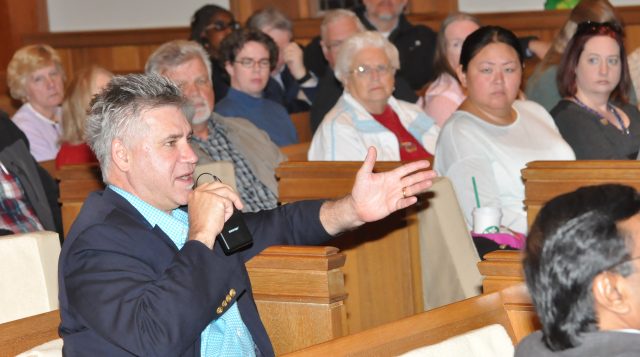Bishop Peggy Johnson, with her Cabinet and staff, completed scheduled town hall meetings in all six districts in April to present their proposal to reduce the conference’s six districts to four. And while the proposal’s primary objective is to reduce costs in the face of shrinking resources, it offers ideas for enhancing ministry as well.
Bishop Johnson prefaced her presentation with highlights of ministries across the conference worth celebrating and then offered her rationale for redistricting. She shared extensive information that, despite the vibrancy of our ministries, showed our decline in the number of churches, local church membership and connectional finances.
The number and percentage of churches paying 100 percent of their remittances has steadily increased since 2012—from 269 or 60 percent to 275 or 66 percent. But the number of churches in the conference has dropped from 444 to 417, and 142 churches (or about 34 percent) are not paying 100 percent of their remittances.
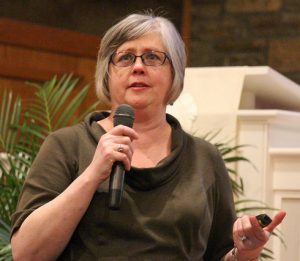 Treasurer Jim Cruickshank and Health and Pension Benefits Director Jo Fielding reported on our efforts to attain a 100 percent funded status for our currently under-funded Pre-1982 Clergy Pensions liability by 2021 and to address other financial challenges. Those other challenges include the costs of supporting conference-wide ministries and financial operations, and of paying property insurance costs and health benefits for clergy and conference lay employee.
Treasurer Jim Cruickshank and Health and Pension Benefits Director Jo Fielding reported on our efforts to attain a 100 percent funded status for our currently under-funded Pre-1982 Clergy Pensions liability by 2021 and to address other financial challenges. Those other challenges include the costs of supporting conference-wide ministries and financial operations, and of paying property insurance costs and health benefits for clergy and conference lay employee.
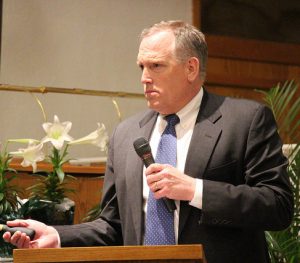
With a 2015 budget of $17.5 million, the Conference collected only $15.4 million, a declining 88 percent collection rate. Nearly a half-million dollars billed to the churches for the denomination’s General Church and World Service funds was not paid. More than $200,000 in the Connectional Ministries Fund budget was not spent due to uncertainty around church giving levels. And the Conference also had to borrow funds for, and delay payments on, medical and property insurance bills.
Several possible solutions considered
For short-term solutions, the Conference withdrew funds from Trustee Board reserves and took an advance on the 2016 year-end payment from the Board of Pension and Health Benefits. But the Conference is reluctant to raise income by hiking charges to already strapped churches. And increasing the bill collection rate is a tough hurdle that requires a truly cooperative, connectional effort if the conference is to continue providing churches with corporate medical and property insurance rates.
Three longer-term solutions were also not deemed viable: to reduce conference ministry programs and services any further; to reduce an already depleted conference workforce any further; or to eliminate conference-administered benefits and insurance programs.
The Conference identified “historical balances” as a recent and future source of funds to help pay insurance and benefits expenses. Historical balances are billed amounts that churches may not have paid during financially challenging times but which are still owed to the Conference and needed to help pay for mission and ministry, medical insurance, retirement benefits and property insurance. Many faithful churches, after recovering from their challenges, enact a plan to pay off these balances, although sometimes the balances have been repaid from the sale of church property.
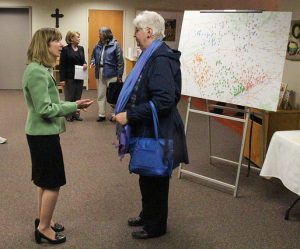 While a considerable number of churches are closing, merging and downsizing, resulting in decreased apportionment payments, said Bishop Johnson, many are missional churches that are still reaching and serving the poor in large numbers. Yet, many of them are no longer able to sustain a full-time pastor. And guaranteed appointments for clergy elders serving such churches often necessitate equitable salary support and other subsidies, along with appointment to multiple-point charges.
While a considerable number of churches are closing, merging and downsizing, resulting in decreased apportionment payments, said Bishop Johnson, many are missional churches that are still reaching and serving the poor in large numbers. Yet, many of them are no longer able to sustain a full-time pastor. And guaranteed appointments for clergy elders serving such churches often necessitate equitable salary support and other subsidies, along with appointment to multiple-point charges.
Bishop Johnson showed a list of 22 conferences that had already reduced their number of districts, some of them by a lot, like our neighbor the Susquehanna Conference. And while Eastern PA Conference districts average about 70 churches (ranging from 64 to 85 with the Northwest District having the largest number), the average number of churches served by superintendents in geographically similar districts elsewhere in the U.S. is 108.
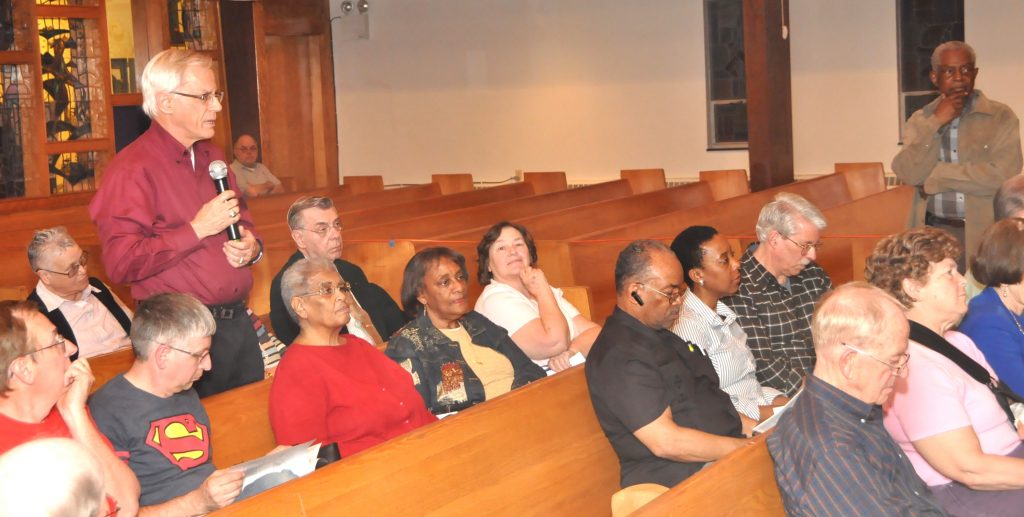
Reduction of districts offered as best solution
All the information presented clearly led to the conclusion that reducing our districts from six to four would be the best long-term solution. Bishop Johnson displayed maps with colored pins first showing the conference as divided currently in six districts, and then as proposed in four districts: North, East, South and West.
Detailed maps of each new proposed new district were shown: the North District with 112 churches, the East with 96 churches, the South with 104 churches and the West with 106 churches. The bishop then presented one map showing district locations of the conference’s 18 Latino, Korean, multi-ethnic churches and another map depicting locations of the 27 African-American churches, all in the East and South districts.
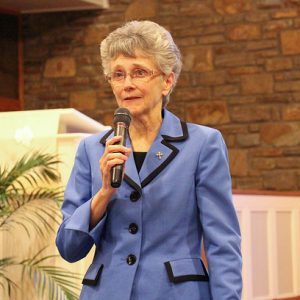 She also offered a timeline for the proposed redistricting process, beginning with these district town hall meetings and then conversations at Annual Conference in June, with no vote taken. The Adjourned Session of Annual Conference, scheduled to meet Oct. 1 at Bethany UMC’s Macungie Campus, is expected to vote on the proposal for redistricting. If a new bishop is assigned to lead the conference as of September, she or he can decide whether or not to proceed with the vote.
She also offered a timeline for the proposed redistricting process, beginning with these district town hall meetings and then conversations at Annual Conference in June, with no vote taken. The Adjourned Session of Annual Conference, scheduled to meet Oct. 1 at Bethany UMC’s Macungie Campus, is expected to vote on the proposal for redistricting. If a new bishop is assigned to lead the conference as of September, she or he can decide whether or not to proceed with the vote.
If the members approve the redistricting, transition efforts will last until June 30, 2017. And on the next day, July 1, 2017, “We will officially begin living with 4 districts,” said the bishop.
Many questions answered in presentation
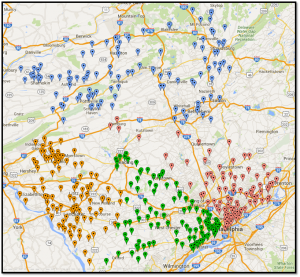
Proposed 4-district map. Maps of individual proposed districts are found in the Powerpoint presentation slides.
She ended her presentation with answers to a list of likely questions. The first was about savings. The redistricting is expected to save nearly $400,000 each year, a net amount after adjustment expenses to compensate for larger districts and a heavier workload.
But the savings would not be significant enough if the proposed reduction was only to five districts, she said. The Cabinet also decided against that number because “the geography and natural affinity of communities across the conference does not lend itself to five districts,” she asserted.
The redistricting would not produce any savings to churches because any funds saved would be used to meet the burden of conference financial obligations. Bishop Johnson reminded listeners that local church apportionments “are based solely on your church’s budget, not on the conference office’s budget.”
Other expected changes include:
- The Rev. Joe Tyson will serve as interim Superintendent of the Northwest District for one year, beginning July 1, as the Rev. Gary Nicholson returns to serve a local church.
- The Rev. Dr. Anita Powell, Superintendent of the Central District, will complete her six years on the Cabinet in July 2017 and will also return to serve a local church.
- Two District Resource Assistant positions would be eliminated.
- Mission Connections and other small groups would be developed more to increase ministry coordination and connectional resourcing.
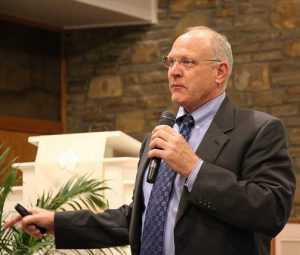 With the four proposed districts more spread out than before—especially the North District—the conference would explore the use of video conferencing technology to enable groups and individuals to meet optionally through video calls and help ensure greater participation. The Mid-Atlantic UM Foundation plans to use more video conferencing technology in its work, including live streaming and video on demand for programs and education, reported Executive Director Jack Brooks. He explained that it can also make those resources available to the conference.
With the four proposed districts more spread out than before—especially the North District—the conference would explore the use of video conferencing technology to enable groups and individuals to meet optionally through video calls and help ensure greater participation. The Mid-Atlantic UM Foundation plans to use more video conferencing technology in its work, including live streaming and video on demand for programs and education, reported Executive Director Jack Brooks. He explained that it can also make those resources available to the conference.
There were few questions or concerns raised at the various town hall meetings after Bishop Johnson’s comprehensive presentation and Q & A. But more questions and answers may follow before and during the upcoming District and Annual conferences prior to the Oct.1 vote.
In the meantime, her closing comment reflected on the timely Christian season of Eastertide and Jesus’ resurrection, which “teaches us that change brings about a new way of life.
“It conquers loss,” she said. “It is not the end, but it’s another beginning.”
By John W. Coleman, Eastern PA Conference Communications Director
Photos by Sabrina Daluisio and John Coleman.
Note: The Powerpoint presentation slides for the Re-districting information presented to Districts in April 2016 [PPT download] can be found on our Website under Resources.
| It is the responsibility of the annual conference membership to determine the number of districts.
It is the responsibility of the bishop to form the districts after consultation with the district superintendents and after the number of the districts has been determined by vote of the annual conference (Para 415.4, Book of Discipline 2012, Judicial Council Decision 422) |

